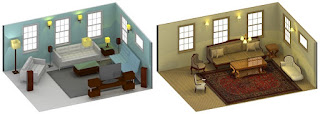UMass Amherst Computer Scientists Introduce New Graphics Software
August 11, 2015
AMHERST, Mass. – Computer scientists from the University of Massachusetts Amherst led by Evangelos Kalogerakis today unveiled a new software modeling program that uses sophisticated geometric matching and machine learning to successfully mimic the human perception of style, giving users powerful new tools to compare the style similarity of three-dimensional (3D) objects.
 |
| Computer Scientists Introduce a New Software Modeling Program |
Kalogerakis is an expert in developing computational techniques that analyze and synthesize visual content, focusing on machine learning algorithms that help people to create 3D models. To develop the new software, he and colleagues drew on observations about style similarity in art history and appraisal literature, which provided geometric elements including shape, proportion and lines, and visual motifs as key indicators of stylistic similarity.
They also used crowdsourcing to present object’s style comparisons to more than 2,500 people, including artists, who volunteered via Amazon Mechanical Turk on the Internet. This yielded more than 50,000 responses on seven structurally diverse categories, buildings, furniture, lamps, coffee sets, architectural pillars, cutlery and dishes. The human respondents agreed on style similarity on average 85 percent of the time.
As for the software tool, the researchers evaluated it by comparing its responses to the human evaluations and found that it achieves “a surprising agreement rate” of 90 percent, Kalogerakis reports, “making it your next-to-best alternative style expert for providing you with suggestions of objects to populate your home, dining table, or virtual reality environment.”
As he explains, computer graphics algorithms help people create movies, visual effects, games, virtual and augmented reality environments. They are also useful in manufacturing real objects and designing architectural scenery. More generally, the new algorithm is expected to be useful to those exploring databases of digital representations of buildings, pillars and other objects according to style attributes for designing virtual or real environments, creating content for a computer game, and populating an augmented reality environment with virtual objects.
Computer algorithms also run in the background on many devices, as well, he says, such as spell and grammar checkers, programs that deblur photographs or focus on faces. Robots run computer algorithms to recognize their environment to move around and pick up objects. Online search engines run computer algorithms to help users find documents, pictures and videos.
SIGGRAPH members include researchers, developers and users from the technical, academic, business and art communities who use computer graphics and interactive techniques. ACM is the world’s largest educational and scientific computing society for educators, researchers and professionals to inspire dialogue, share resources and address the field’s challenges.
Following links gives more information about new software modeling program
Elements of Style: Learning Perceptual Shape Style Similarity (PDF)
News Release Source : UMass Amherst Computer Scientists Introduce New Graphics Software
Image Credit : University of Massachusetts